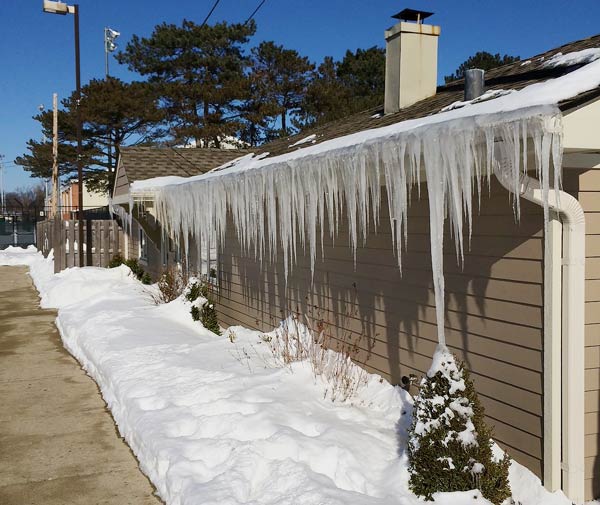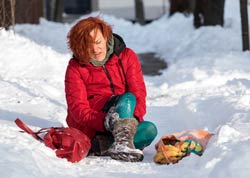 Tennis Shack — Winnetka Park District
Tennis Shack — Winnetka Park District
Preventing the Cold Weather Blues
Winter weather creates special circumstances for park districts to address, but you can stay ahead of them by following a thorough inspection program like the one John Barrett, Facilities Maintenance Supervisor, Winnetka Park District, uses.
Early Prep Is Key
 “Keeping patrons safe is our top priority,” Barrett explains. “Some of our most popular programs run during the winter, so we make sure all our snowplows, snow blowers and snow removal equipment is ready to go at a moment’s notice. We order plenty of sidewalk salt to get us through the season, and we have all our furnaces inspected prior to the cold weather to make sure they stay functioning all winter. But just in case they don’t, we also have extra electric heaters on hand. After a snowstorm, we clear and salt all parking lots and sidewalks leading to and from our buildings. Our parks maintenance staff rotates on a seven-day, on-call schedule to be ready for snowstorms.” “Keeping patrons safe is our top priority,” Barrett explains. “Some of our most popular programs run during the winter, so we make sure all our snowplows, snow blowers and snow removal equipment is ready to go at a moment’s notice. We order plenty of sidewalk salt to get us through the season, and we have all our furnaces inspected prior to the cold weather to make sure they stay functioning all winter. But just in case they don’t, we also have extra electric heaters on hand. After a snowstorm, we clear and salt all parking lots and sidewalks leading to and from our buildings. Our parks maintenance staff rotates on a seven-day, on-call schedule to be ready for snowstorms.”
Barrett starts inspecting closed buildings in December, when the temperatures can drop below freezing. If the agency has a facility closed for a couple weeks over the holidays, it becomes a priority to do a quick walkthrough several times to ensure there are no issues. “If an unoccupied building has heat, we check it weekly to make sure the heaters are operational,” he says. “In case of far-below-freezing temperatures, we take the necessary steps to prevent an emergency — including having staff come in after hours and on weekends to ensure we don’t miss any potential issues.”
Tricky Problems
Barrett points out several tricky areas that can trip up even the most diligent inspection program. “Making sure ejector systems and sump pumps function properly during the winter is, in my opinion, an area easy to overlook. But you should check them frequently,” he adds. Especially deserving of inspection are sprinkler rooms, wet walls (if accessible) and storage closets with sprinkler heads.
“My agency has four lakefront restroom shelters. None of these facilities have heat, so every fall we perform a very thorough winterization process. Spring is a very busy time of year for every park district,” he notes, “so it benefits our agency to spend extra time in the fall to do everything properly versus finding out in the spring we have a time-consuming leak to repair. It’s also a good idea to develop a facility-specific checklist for winterizing each location.”
Do a “Deep Dive” Inspection
 Barrett’s own recent experience shows the wisdom of a thorough inspection. “During the polar vortex of 2019, I was inspecting one of our restroom facilities that’s open year-round; it has thermostat-controlled electric heaters,” he explains. “Even though the heaters were working, and the restrooms were warm, I noticed neither the toilets nor faucets were working properly. As a precaution, I shut off the water to the building and locked down the facility. We later discovered a water pipe in the wall froze and would have eventually burst. Had I not done that inspection and taken preventive steps, there would have been significant flooding damage.” Barrett’s own recent experience shows the wisdom of a thorough inspection. “During the polar vortex of 2019, I was inspecting one of our restroom facilities that’s open year-round; it has thermostat-controlled electric heaters,” he explains. “Even though the heaters were working, and the restrooms were warm, I noticed neither the toilets nor faucets were working properly. As a precaution, I shut off the water to the building and locked down the facility. We later discovered a water pipe in the wall froze and would have eventually burst. Had I not done that inspection and taken preventive steps, there would have been significant flooding damage.”
In addition to Barrett’s inspection recommendations, PDRMA also suggests checking these areas for winter readiness:
- Inspect low temperature alarms in areas of buildings with sprinkler system piping, such as hallways and vestibules.
- Ensure interior temperature is above 55 degrees to prevent pipes freezing if the building isn’t properly winterized.
- Check HVAC systems to ensure proper operation, especially in buildings not occupied on a regular basis.
- If possible and safe to do so, inspect roofs for water, ice and snow buildup that can create problems.
- Check exposed and exterior pipes for signs of freezing. (Insulate if possible.)
- If there is a fire hydrant near your buildings, be sure to remove snow from it.
|

